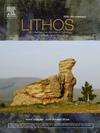New magmatic record of Indian continental subduction at ca. 50 Ma: Evidence from ultrapotassic–potassic lamprophyre dikes in the Gangdese Batholith, Southern Tibet
IF 2.9
2区 地球科学
Q2 GEOCHEMISTRY & GEOPHYSICS
引用次数: 0
Abstract
Geophysical and geochemical evidence confirmed the northward-directed Indian continental lithosphere subduction beneath the Gangdese orogen, however, the geodynamic processes responsible for the transition from the Neo-Tethyan subduction to the Indian continental subduction, particularly magma generation mechanisms regarding the 53–42 Ma magmatic flare-up events, remain poorly constrained. Here we have conducted a comprehensive investigation combining geochemical and geochronological studies of newly discovered Early Eocene (ca. 50–47 Ma) ultrapotassic–potassic lamprophyre dikes in the Lhasa terrane, Tibet. The ultrapotassic lamprophyres revealed highly evolved Sr–Nd–Pb isotopes and high concentrations of incompatible elements, and are thought to have originated from the Indian lithospheric mantle. In contrast, the potassic lamprophyres, displaying relatively depleted Sr–Nd–Pb isotopes and lower MgO contents and K2O/Na2O ratios than the ultrapotassic lamprophyres, show high Sr/Y and low Y geochemical signatures, thereby demonstrating that they formed due to contamination of the ultrapotassic lamprophyre magma by adakitic melts. We, therefore, propose that the lamprophyres represent a new magmatic record of the Indian lithosphere, suggesting that the subduction of Indian plate beneath the Lhasa terrane was already operating at ca. 50 Ma. The data gained here in conjunction with published data further suggest that the upwelling asthenosphere associated with the Neo-Tethyan slab breakoff caused the significant melting of both mantle and crust.
求助全文
约1分钟内获得全文
求助全文
来源期刊

Lithos
地学-地球化学与地球物理
CiteScore
6.80
自引率
11.40%
发文量
286
审稿时长
3.5 months
期刊介绍:
Lithos publishes original research papers on the petrology, geochemistry and petrogenesis of igneous and metamorphic rocks. Papers on mineralogy/mineral physics related to petrology and petrogenetic problems are also welcomed.
 求助内容:
求助内容: 应助结果提醒方式:
应助结果提醒方式:


